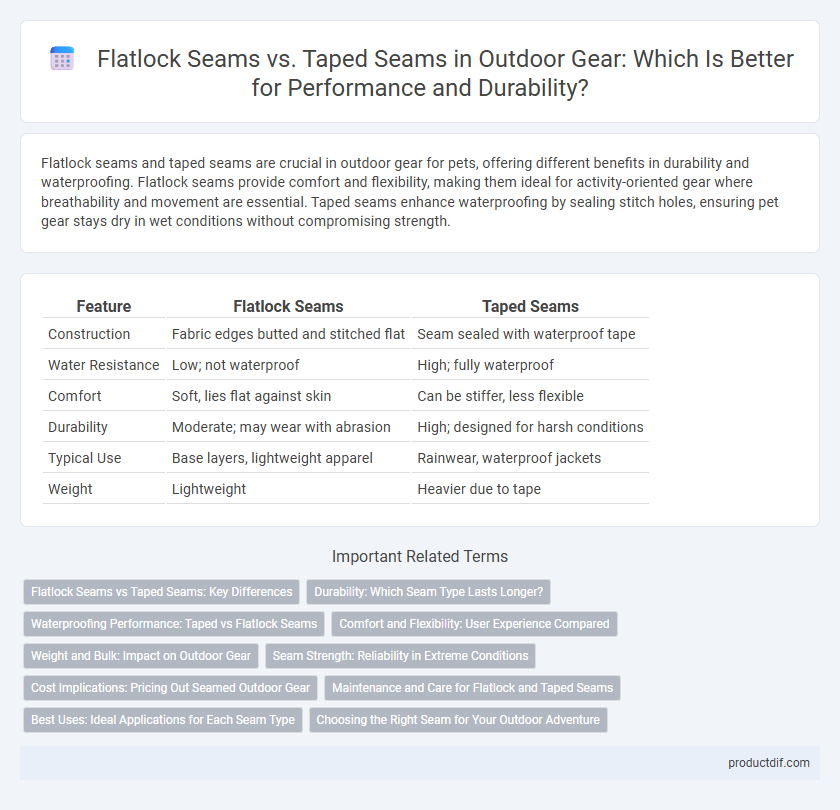Flatlock seams and taped seams are crucial in outdoor gear for pets, offering different benefits in durability and waterproofing. Flatlock seams provide comfort and flexibility, making them ideal for activity-oriented gear where breathability and movement are essential. Taped seams enhance waterproofing by sealing stitch holes, ensuring pet gear stays dry in wet conditions without compromising strength.
Table of Comparison
| Feature | Flatlock Seams | Taped Seams |
|---|---|---|
| Construction | Fabric edges butted and stitched flat | Seam sealed with waterproof tape |
| Water Resistance | Low; not waterproof | High; fully waterproof |
| Comfort | Soft, lies flat against skin | Can be stiffer, less flexible |
| Durability | Moderate; may wear with abrasion | High; designed for harsh conditions |
| Typical Use | Base layers, lightweight apparel | Rainwear, waterproof jackets |
| Weight | Lightweight | Heavier due to tape |
Flatlock Seams vs Taped Seams: Key Differences
Flatlock seams feature overlapping fabric edges sewn together with multiple stitches, providing flexibility and reducing bulk, ideal for active outdoor gear where comfort and mobility are crucial. Taped seams reinforce stitched seams by applying waterproof tape over the seam line, ensuring superior water resistance in rain jackets and waterproof gear. The key difference lies in flatlock seams prioritizing comfort and reduced chafing, while taped seams focus on enhancing waterproof performance.
Durability: Which Seam Type Lasts Longer?
Flatlock seams provide moderate durability by laying fabric edges flat and stitching them closely, reducing bulk and preventing chafing but are more prone to wear under heavy abrasion. Taped seams offer superior durability and waterproof protection by covering stitch holes with a strong adhesive tape, effectively sealing the fabric and enhancing seam strength against stress and moisture. For outdoor gear subjected to rough conditions and extended use, taped seams generally last longer and maintain integrity better than flatlock seams.
Waterproofing Performance: Taped vs Flatlock Seams
Taped seams provide superior waterproofing performance by sealing stitch holes with waterproof tape, preventing water penetration even under heavy rain or prolonged exposure. Flatlock seams, while more breathable and comfortable, lack the waterproof tape and are therefore more prone to water seepage, making them less ideal for wet weather conditions. Outdoor gear featuring taped seams is preferred for activities requiring reliable waterproof protection, such as hiking, camping, and mountaineering in diverse climates.
Comfort and Flexibility: User Experience Compared
Flatlock seams offer superior comfort by minimizing bulk and reducing skin irritation, making them ideal for active outdoor gear worn during extended periods. Taped seams provide enhanced waterproofing and durability but can feel stiffer, potentially limiting flexibility and causing discomfort in activities requiring high mobility. Users seeking maximum comfort and freedom of movement often prefer flatlock seams for base layers and garments worn next to the skin.
Weight and Bulk: Impact on Outdoor Gear
Flatlock seams reduce weight and bulk in outdoor gear by lying flat and eliminating excess fabric layers, enhancing comfort and flexibility during physical activities. Taped seams, while adding waterproofing and durability, increase garment weight and thickness due to the adhesive tape applied over seam lines. Lightweight outdoor enthusiasts often prefer flatlock seams for breathable, low-profile clothing, whereas taped seams suit wet conditions requiring robust weather protection despite added weight.
Seam Strength: Reliability in Extreme Conditions
Flatlock seams provide moderate strength and breathability, making them suitable for lightweight outdoor gear in mild conditions. Taped seams create a fully waterproof and highly durable bond, ensuring maximum reliability under extreme weather and strenuous outdoor activities. For extreme conditions, taped seams offer superior seam strength and protection against water ingress compared to flatlock seams.
Cost Implications: Pricing Out Seamed Outdoor Gear
Flatlock seams generally reduce manufacturing costs by using less fabric and simpler stitching techniques, resulting in more affordable outdoor gear. Taped seams involve additional materials and labor to apply waterproof tape, significantly increasing production expenses and retail prices. Consumers seeking budget-friendly outdoor apparel often favor flatlock-seamed products, while taped seams appeal to those prioritizing premium waterproof performance despite higher costs.
Maintenance and Care for Flatlock and Taped Seams
Flatlock seams require gentle washing in cold water and air drying to prevent seam damage and maintain flexibility, while avoiding high heat that can weaken stitching. Taped seams need careful attention to avoid abrasion during washing and should be air dried or tumble dried on low heat to preserve the waterproof seal. Both seam types benefit from using mild detergents free of bleach or fabric softeners to extend the lifespan of outdoor gear.
Best Uses: Ideal Applications for Each Seam Type
Flatlock seams excel in active outdoor gear where breathability and comfort are crucial, making them ideal for base layers, leggings, and running apparel. Taped seams provide superior waterproofing and durability, perfect for rain jackets, hiking pants, and gear exposed to harsh weather conditions. Choosing between these seam types depends on prioritizing moisture management or weather protection for specific outdoor activities.
Choosing the Right Seam for Your Outdoor Adventure
Flatlock seams offer enhanced comfort and flexibility, making them ideal for active outdoor gear where chafing and movement are concerns. Taped seams provide superior waterproofing and durability, perfect for gear exposed to wet and harsh weather conditions. Selecting the right seam depends on the balance between comfort and weather resistance needed for your specific outdoor adventure.
Flatlock seams vs Taped seams Infographic

 productdif.com
productdif.com